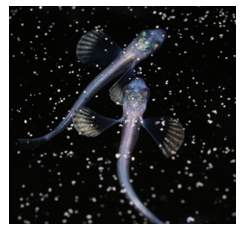FULL-FILLING THE PROMISE OF SABLEFISH Anoplopoma fimbria GENOMICS: SEX-TESTING, PARENTAGE ANALYSES, WHOLE-GENOME SEQUENCING AND GENOME PREDICTION
At the Golden Eagle Sablefish (GES) hatchery on Saltspring Island (British Columbia) eggs and sperm from wild-caught and hatchery-reared captive brood stock are used to generate offspring that spend approximately 1 year in the hatchery and 1 year in ocean pens at Kyuquot Sound (Vancouver Island). Embryo- and larval-stage mortality is highly variable and beyond 2 months of age growth rate varies with fish ranging from <2 kg to almost 5 kg at the time of processing. Efforts to support slow-growers by separating them from larger fish and enhancing their diet have been largely unsuccessful, thus a proportion of the population (referred to as ‘drop-outs’ by GES staff) fails to convert food into flesh after reaching about 1.8 kgs.
The research discussed here is a collaboration involing the University of Victoria, GES, and the KA:’YU:’K’T’H’ and CHE:K:TLES7ET’H’ First Nations. We have developed, or are currently developing, molecular tools for sexing sablefish, for parentage analyses, and for Genome-Wide Association Studies and Genome Prediction in an effort to assess the influence of genetics on the phenotypic variation briefly described above.
Genetic and genomic data have played a major role in the improvement of long-domesticated species (e.g., dairy cattle) and in the development of new domestic lineages (e.g., Atlantic salmon). In the case of sablefish, these new tools will allow us to i ) test the hypothesis that males make up a large proportion of the ‘drop-out’ population, ii) determine whether or not a new ‘neomale ’ breeding program is producing all-female broods, iii) identify crosses that contribute disproportionately to fast or slow growers, iv) enhance the deployment of the largely wild-caught brood stock population, and v) recruit brood stock from the captive population that are more-likely to produce progeny with high survival, growth rate, and health metrics. Our long-term goal is to develop an exceptional domestic population. Progress made during the first six months of this collaboration will be presented.
